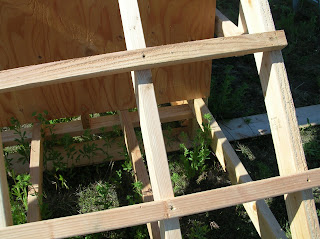 If you are fairly computer literate and want to design something, the I recommend downloading Google SketchUp. There is a learning curve for the program, but they have videos to help you with that. This will help by allowing you to see what you are putting together before you commit materials. I used it to generate a parts list as well. The drawing is not complete, but it's complete enough for what I need it for. Converting a pile of lumber into a chicken tractor with this picture as a guide would not have been too difficult if that was all I had to deal with.
If you are fairly computer literate and want to design something, the I recommend downloading Google SketchUp. There is a learning curve for the program, but they have videos to help you with that. This will help by allowing you to see what you are putting together before you commit materials. I used it to generate a parts list as well. The drawing is not complete, but it's complete enough for what I need it for. Converting a pile of lumber into a chicken tractor with this picture as a guide would not have been too difficult if that was all I had to deal with. The doors open wide and at 4 feet deep, it will be easy to clean.
The doors open wide and at 4 feet deep, it will be easy to clean.I was hit in the lungs by some virus so hard that by day 2 I was wondering if I needed to go to the hospital. After a week I was not ill anymore, but my lungs itched and I continued to be short of breath and cough for a full month. In addition to this, our unusually dry and warm winter turned into a record breaking wet spring. While the chicks were ready to leave the brooder at 3 weeks, they had to spend an extra week in the brooder while I continued to build.
 A sliding door between the coop and chicken run allows chicken control.
A sliding door between the coop and chicken run allows chicken control.I put a 2x3 piece of plywood in the front right corner to put their food and water on. Some of my available information said that chicks don't do well on the 1/4 inch wire mesh floor, so I tacked a 4x4 piece of plywood over the left side of the floor with two screws.
 I was unsure whether the chickens could reach the roost, so I added a lower second one.
I was unsure whether the chickens could reach the roost, so I added a lower second one.The openings in the doors are for nest boxes. The triangles on either side are for storage.
 I ripped 2x4s in half for 2x2 purlins to hook the roofing to. I used old sheets of galvanized roofing on the roof.
I ripped 2x4s in half for 2x2 purlins to hook the roofing to. I used old sheets of galvanized roofing on the roof.On the last day they were in the brooder, I forgot to open the windows on the car until near 11 AM and nearly cooked them. Finally late that day we moved them from the now over crowded brooder to the coop. Somehow I have managed to not loose a single chicken.
 I printed off a chicken silhouette I found on the internet and cut the shape out for a decorative window.
I printed off a chicken silhouette I found on the internet and cut the shape out for a decorative window.This relieved the crowding problem for a time, but I was left with a feeding problem. They were consuming and loosing through the floor an entire bag of feed every couple of weeks. Manure build up in side the coop was also an issue I could do nothing about, because I had nowhere for the chickens to go. I had to get the chicken run done.






